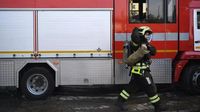Kursk, a city in western Russia, faced a devastating drone attack early on April 15, 2025, resulting in significant destruction and loss of life. The assault began shortly after midnight, with a series of powerful explosions reported across the city, prompting immediate response from Russian air defense systems.
According to the operational headquarters of the Kursk region, the drone strike was described as a "massive attack" targeting civilian infrastructure. Eyewitness accounts detailed at least two dozen explosions, as residents reported chaos in the skies above them. Local news outlets, including Kurskiye Izvestiya and DDD, confirmed that the explosions caused fires in multiple residential buildings, including a multi-story apartment complex on Orlovskaya Street.
The aftermath of the attack was severe. Fires erupted on five floors of the apartment building, with reports indicating that the eighth and ninth floors of another building on Zavodskaya Street were also affected. Firefighters battled the blazes throughout the morning, a daunting task given the extent of the damage.
Tragically, the attack claimed the life of an 85-year-old woman. In total, nine individuals sustained injuries ranging from shrapnel wounds to traumatic brain injuries and burns. The local emergency services were quick to respond, evacuating residents from the affected buildings and providing temporary accommodation for those displaced.
Images emerging from the scene depicted the grim reality of the attack: charred buildings, shattered windows, and debris littering the streets. The Telegram channel Baza reported that five houses were damaged and confirmed the casualties. The visual evidence underscored the impact of the drone assault, leaving a visible scar on the community.
As the day unfolded, further details emerged about the scale of the destruction. The Ministry of Emergency Situations managed to contain the fires, but the damage was extensive. Reports indicated that an ambulance garage was also struck, resulting in damage to 11 emergency vehicles, complicating the local response capabilities.
Local authorities were quick to issue statements, emphasizing the need for vigilance amid ongoing threats. The operational headquarters noted that the attack was part of a broader pattern of aggression targeting civilian areas, raising alarms about the safety of residents.
This incident is not an isolated event. Just a day prior, on April 14, explosions were reported in the Tula region, where Ukrainian drones attempted to strike the Aleksinskaya thermal power plant. The continued drone assaults highlight the escalating tensions in the region, with civilian areas increasingly caught in the crossfire.
The community of Kursk is now grappling with the aftermath of this traumatic event. As residents begin to assess the damage and mourn their losses, questions arise about the effectiveness of air defense systems and the protection of civilians in conflict zones. The attack has sparked outrage and fear among locals, many of whom are calling for increased security measures.
In the wake of the attack, the Russian government faces mounting pressure to address the growing threat posed by drone warfare. Analysts suggest that the frequency and intensity of such assaults could escalate further, forcing authorities to reconsider their defense strategies.
The international community is also watching closely, as the implications of these attacks extend beyond the immediate region. The potential for broader conflict remains a concern, with diplomatic efforts necessary to de-escalate tensions.
As Kursk begins to recover from this tragic event, the resilience of its residents will be tested. Community leaders are rallying support for those affected, emphasizing the need for solidarity in the face of adversity. The coming days will be crucial for the city as it seeks to rebuild and heal from the scars of this drone attack.
In summary, the drone attack on Kursk on April 15, 2025, serves as a stark reminder of the dangers facing civilian populations in conflict zones. With lives lost and communities shattered, the need for effective protection and diplomatic solutions has never been more urgent.








